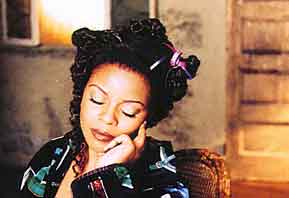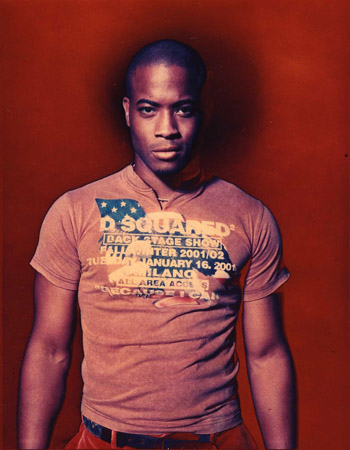SHAUN ESCOFFERY / “Feeling Good”
Aural wallpaper. Stuff you put on while you’re doing tasks around the house. You know, like cleaning, ironing, working on the computer, reading a book. Something pleasant that you don’t have to…well, they call it easy listening. The biggest contradiction with easy listening music is that, when you do focus in on the listening experience, there’s usually nothing much there to listen to.
 Maysa Leak, former lead singer with Incognito, and Shaun Escoffery, latest soul phenom out of England, have recently issued albums based on classic soul sounds. It’s dangerous to do an album of covers of classic music, not only because you’re going to be compared to artists that are already considered great but also because you’re going to be up against not one or two but rather a bevy of artistic heavyweights, sort of like having to take on Jack Johnson, Joe Lewis, Muhammad Ali, Mike Tyson and Lennox Lewis back to back to back to back when all of them are in their prime. Why even try?
That said, both Maysa and Shaun dare to attempt the impossible and in so doing take different approaches. Maysa, with her gigantically gorgeous voice, wraps herself in a warm waterfall of sensuous sounds. Smooth jazz stations will undoubtedly eat this stuff up. Beautiful melodies, lush orchestration, lightly tinkling percussion, ooh-ing and aah-ing background singers providing a bed of note-perfect harmonies, scintillating keys hitting major chords, lush horn accents judiciously employed, soft soaring strings shoring up the choruses and, finally, Maysa floating around, above and through it all.
Maysa Leak, former lead singer with Incognito, and Shaun Escoffery, latest soul phenom out of England, have recently issued albums based on classic soul sounds. It’s dangerous to do an album of covers of classic music, not only because you’re going to be compared to artists that are already considered great but also because you’re going to be up against not one or two but rather a bevy of artistic heavyweights, sort of like having to take on Jack Johnson, Joe Lewis, Muhammad Ali, Mike Tyson and Lennox Lewis back to back to back to back when all of them are in their prime. Why even try?
That said, both Maysa and Shaun dare to attempt the impossible and in so doing take different approaches. Maysa, with her gigantically gorgeous voice, wraps herself in a warm waterfall of sensuous sounds. Smooth jazz stations will undoubtedly eat this stuff up. Beautiful melodies, lush orchestration, lightly tinkling percussion, ooh-ing and aah-ing background singers providing a bed of note-perfect harmonies, scintillating keys hitting major chords, lush horn accents judiciously employed, soft soaring strings shoring up the choruses and, finally, Maysa floating around, above and through it all.
 This is Sunday music, soothing music (especially Maze's "Happy Feeling" and Lionel Richie's "Zoom"), perfect for a slow cruise on a warm spring day or perhaps a honey-sweetened cup of herbal tea after a half hour soak in a hot tub. Before you know it, you’re happily humming along. Maysa picked soul ballads that most adults know; although she is a superb vocalist, the emphasis is actually on setting and maintaining a mood of romance (either as in nostalgic reminiscing or as aural foreplay and unobtrusive accompaniment).
There have been tons of attempts of this formula (indeed, Maysa’s previous album was in the same vein). What I like about this one as opposed to many others is the production package: a good selection of songs, luxurious arrangements and an interesting lead vocalist. Feel The Fire is great for what it is, even if it doesn’t aim to be anything more than beautiful background music.
This is Sunday music, soothing music (especially Maze's "Happy Feeling" and Lionel Richie's "Zoom"), perfect for a slow cruise on a warm spring day or perhaps a honey-sweetened cup of herbal tea after a half hour soak in a hot tub. Before you know it, you’re happily humming along. Maysa picked soul ballads that most adults know; although she is a superb vocalist, the emphasis is actually on setting and maintaining a mood of romance (either as in nostalgic reminiscing or as aural foreplay and unobtrusive accompaniment).
There have been tons of attempts of this formula (indeed, Maysa’s previous album was in the same vein). What I like about this one as opposed to many others is the production package: a good selection of songs, luxurious arrangements and an interesting lead vocalist. Feel The Fire is great for what it is, even if it doesn’t aim to be anything more than beautiful background music.
 Shaun Escoffery on the other hand lifts it up a notch with his new album, Move Into Soul. I suspect a lot of it has to do with Shaun hooking up with producer/songwriter Geoffrey Williams. The arrangements are actually original and engaging rearrangements of music most of us thought we knew by heart; now that Shaun has stepped to it though, what we have are sincere and beautiful reconsiderations. Check out how he engages the Timmy Thomas anthem “Why Can’t We Live Together.” From the breakdowns to the layered voices on the back end, this is one truly interesting remake.
None of the songs are done like the originals but neither are they radically redone just for the sake of being different. These are not novelty arrangements. “She’s Gone” is the closest Shaun gets to a standard kind of remake, but even it has elements that are completely new yet seem to fit perfectly. Shaun is great at enunciating and communicating the lyrics, emphasizing not just the feeling but also the meaning.
When it comes to message songs, his is the most innovative and yet reverent version of “A Change Is Gonna Come” that I’ve heard. It’s uncanny how Shaun is able to employ some of Sam Cooke’s trademark phrasing and yet offer a stylistically unique statement.
“Feeling Good” is absolutely the pinnacle of resurrecting a song that has been done to death. I mean, Nina Simone nailed it. And though there have been some interesting versions, none of them have succeeded on this level. Shaun demonstrates a versatility that his first album hinted at but which is fully realized on this third album (the second album was an album of remixes from the first album). After the first two, I had my man pegged as a club artist, but there is obviously much, much more to Shaun than one approach.
Shaun Escoffery on the other hand lifts it up a notch with his new album, Move Into Soul. I suspect a lot of it has to do with Shaun hooking up with producer/songwriter Geoffrey Williams. The arrangements are actually original and engaging rearrangements of music most of us thought we knew by heart; now that Shaun has stepped to it though, what we have are sincere and beautiful reconsiderations. Check out how he engages the Timmy Thomas anthem “Why Can’t We Live Together.” From the breakdowns to the layered voices on the back end, this is one truly interesting remake.
None of the songs are done like the originals but neither are they radically redone just for the sake of being different. These are not novelty arrangements. “She’s Gone” is the closest Shaun gets to a standard kind of remake, but even it has elements that are completely new yet seem to fit perfectly. Shaun is great at enunciating and communicating the lyrics, emphasizing not just the feeling but also the meaning.
When it comes to message songs, his is the most innovative and yet reverent version of “A Change Is Gonna Come” that I’ve heard. It’s uncanny how Shaun is able to employ some of Sam Cooke’s trademark phrasing and yet offer a stylistically unique statement.
“Feeling Good” is absolutely the pinnacle of resurrecting a song that has been done to death. I mean, Nina Simone nailed it. And though there have been some interesting versions, none of them have succeeded on this level. Shaun demonstrates a versatility that his first album hinted at but which is fully realized on this third album (the second album was an album of remixes from the first album). After the first two, I had my man pegged as a club artist, but there is obviously much, much more to Shaun than one approach.
 When asked about his first album, which has become a classic of club music, Shaun told the BBC: "What I realised very early on was that there are thousands of fantastic vocalists out there, so I needed to find a way that I could stand out from them. I love current R&B, but I knew that if I went down that route I'd just be another drop in the ocean." That Shaun decides to jump head first into an album of soul classics obviously means that he’s confident that he can out swim sharks and out dive whales.
In the final analysis it’s Shaun’s vocal treatments which are paradoxically both intense and understated. If the Maysa music was stuff you would hear in a concert hall, this is the kind of music you hear in your head and feel in your heart when you’re either alone or intimately doubled up. I suppose that’s what’s distinctive about Shaun’s approach—he’s not shouting or showing off trying to raise the roof. Instead, what’s he’s doing is singing to someone whose head lays next to his on the pillow.
—Kalamu ya Salaam
Inspired choices
I've always liked Maysa's music and I've never liked Shaun's, so while I wasn't surprised that I liked Maysa's remakes, I was surprised that I liked Shaun's. I thought I didn't like his voice, but I guess it was more of the club sound that he used to have that I didn't like. To me, he just sounded too clean, too overly sincere. On these songs, he still has that clean sound, but, as Kalamu pointed out, the arrangements are open and patient (if the word 'patient' can be applied to the style of an arrangement). Shaun performs both "Feeling Good" and "Why Can't We Live Together" with a lot of feeling but also with a laid-back confidence that lets you just enjoy the song instead of having to think about how it compares to the classic originals. And that mid-song switch-over on "Why Can't We Live" was an inspired choice. I dig it.
As for Maysa, what can you say? At this point, she's been doing her thing so long and so well, that she's seamlessy, exquisitely perfect. Kalamu is right that it isn't exactly 'serious' music, but really, who cares? It's probably accurate to call it 'supper club R&B,' but only if you happened to go to a supper club where the music was so damn good it made you forget what you had for dinner. Generally speaking, I hate both 'smooth R&B' and 'smooth jazz,' but only because most of the artists are pretending to be something they aren't. Instrumental pop musicians shouldn't try to represent themselves as jazz just because they've had some jazz training, and R&B vocalists shouldn't try to represent themselves as jazz vocalists just because their song selection is a bit more mature than Rihanna's or Beyonce's. Maysa probably does have the chops to sing jazz, but she doesn't sound like she's trying to fool anyone into thinking she's doing so. Maysa is singing picture-perfect remakes of well-known classic R&B, and if you ask me, there ain't a damn thing wrong with that.
—Mtume ya Salaam
When asked about his first album, which has become a classic of club music, Shaun told the BBC: "What I realised very early on was that there are thousands of fantastic vocalists out there, so I needed to find a way that I could stand out from them. I love current R&B, but I knew that if I went down that route I'd just be another drop in the ocean." That Shaun decides to jump head first into an album of soul classics obviously means that he’s confident that he can out swim sharks and out dive whales.
In the final analysis it’s Shaun’s vocal treatments which are paradoxically both intense and understated. If the Maysa music was stuff you would hear in a concert hall, this is the kind of music you hear in your head and feel in your heart when you’re either alone or intimately doubled up. I suppose that’s what’s distinctive about Shaun’s approach—he’s not shouting or showing off trying to raise the roof. Instead, what’s he’s doing is singing to someone whose head lays next to his on the pillow.
—Kalamu ya Salaam
Inspired choices
I've always liked Maysa's music and I've never liked Shaun's, so while I wasn't surprised that I liked Maysa's remakes, I was surprised that I liked Shaun's. I thought I didn't like his voice, but I guess it was more of the club sound that he used to have that I didn't like. To me, he just sounded too clean, too overly sincere. On these songs, he still has that clean sound, but, as Kalamu pointed out, the arrangements are open and patient (if the word 'patient' can be applied to the style of an arrangement). Shaun performs both "Feeling Good" and "Why Can't We Live Together" with a lot of feeling but also with a laid-back confidence that lets you just enjoy the song instead of having to think about how it compares to the classic originals. And that mid-song switch-over on "Why Can't We Live" was an inspired choice. I dig it.
As for Maysa, what can you say? At this point, she's been doing her thing so long and so well, that she's seamlessy, exquisitely perfect. Kalamu is right that it isn't exactly 'serious' music, but really, who cares? It's probably accurate to call it 'supper club R&B,' but only if you happened to go to a supper club where the music was so damn good it made you forget what you had for dinner. Generally speaking, I hate both 'smooth R&B' and 'smooth jazz,' but only because most of the artists are pretending to be something they aren't. Instrumental pop musicians shouldn't try to represent themselves as jazz just because they've had some jazz training, and R&B vocalists shouldn't try to represent themselves as jazz vocalists just because their song selection is a bit more mature than Rihanna's or Beyonce's. Maysa probably does have the chops to sing jazz, but she doesn't sound like she's trying to fool anyone into thinking she's doing so. Maysa is singing picture-perfect remakes of well-known classic R&B, and if you ask me, there ain't a damn thing wrong with that.
—Mtume ya Salaam
This entry was posted on Sunday, August 5th, 2007 at 1:57 am and is filed under Contemporary. You can follow any responses to this entry through the RSS 2.0 feed. You can leave a response, or trackback from your own site.
Leave a Reply
| top |